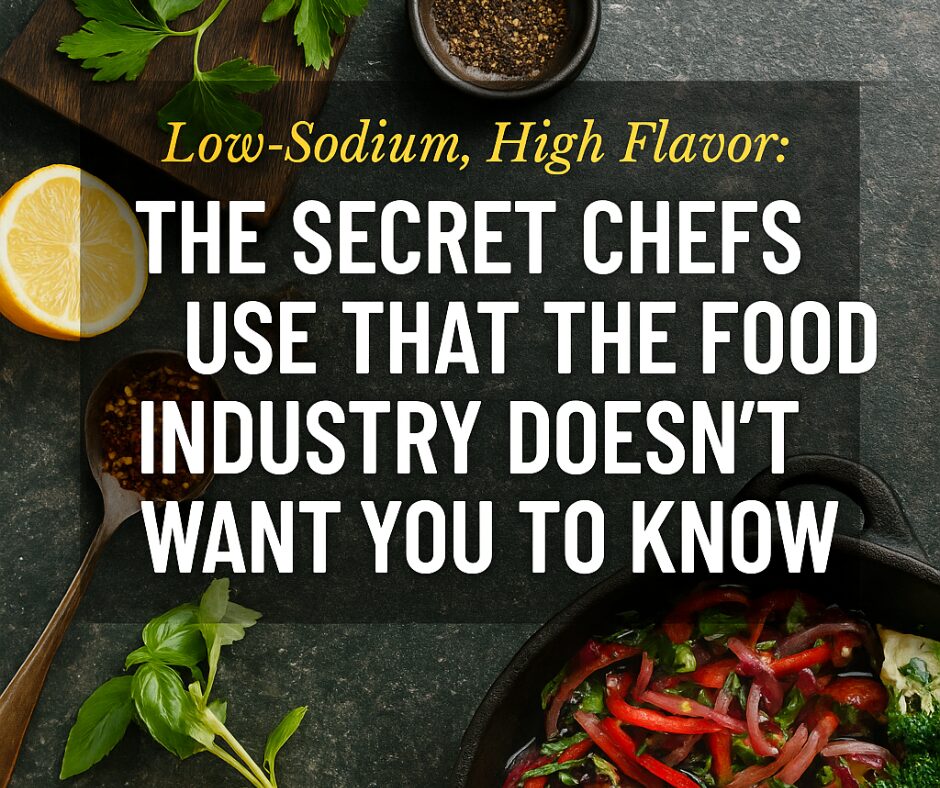In a world where salt is king, flavor has been hijacked by convenience. The average American consumes over 3,400mg of sodium per day, more than double the recommended amount. And yet, the flavor is often flat, one-dimensional, and forgettable. Why? Because the food industry has conditioned our palates to equate salty with tasty, ignoring the deep, complex layers of flavor that real ingredients can deliver.
But behind the scenes, professional chefs have been playing a different game. They know something the processed food industry doesn’t want you to know:
The best flavor doesn’t come from a salt shaker. It comes from technique.
This article pulls back the curtain on the secret arsenal of flavor-building strategies that chefs use to create stunning, crave-worthy meals—without drowning dishes in sodium.
The Salt Trap: How the Food Industry Keeps You Hooked
Salt isn’t just a seasoning. It’s a craving engine. Sodium spikes dopamine, the brain’s feel-good chemical, giving processed food an addictive edge. Add sugar, fat, and artificial flavors to the mix, and you’ve got a product that bypasses satiety signals and keeps you eating.
In restaurants and industrial kitchens, salt is often the shortcut to flavor. But in fine dining and home kitchens rooted in culinary technique, salt is just one note in a much larger symphony.
Flavor by Design: The 5 Secret Weapons of Low-Sodium Chefs
1. Acid (The Unsung Hero)
A splash of acid wakes up the palate like few things can. Lemon juice, vinegar (balsamic, apple cider, red wine), citrus zest, pickled onions, and even fermented ingredients bring brightness and contrast.
Pro Tip: Add a squeeze of lemon at the end of cooking to balance and lift a dish’s flavors.
2. Umami (The Fifth Taste)
Umami is that deep, savory, mouthwatering essence found in mushrooms, tomatoes, nutritional yeast, miso, and even caramelized onions. It’s why parmesan cheese and soy sauce are so addictive—they’re pure umami bombs.
Go-To Ingredients: Miso paste, tamari (low-sodium), tomato paste, anchovy paste, sun-dried tomatoes, mushrooms, seaweed.
3. Fresh Herbs & Aromatics
Salt is static. Herbs are dynamic. Rosemary, thyme, parsley, cilantro, basil, chives, mint—these don’t just season; they transform. Aromatics like garlic, shallots, scallions, and ginger build depth when layered properly in cooking.
4. Heat & Contrast
Spice doesn’t just add heat—it adds contrast. Chili flakes, cracked pepper, horseradish, and wasabi stimulate the palate and allow other flavors to pop, reducing the need for salt.
5. Fermentation & Slow Techniques
Fermented foods like kimchi, miso, sauerkraut, kefir, and yogurt provide tang, funk, and depth. Slow-cooked techniques like roasting and caramelization draw out natural sugars and umami from ingredients.
3 Low-Sodium, High-Flavor Recipes That Prove the Point
1. Charred Cauliflower Tacos with Pickled Red Onion & Chipotle Crema
Flavor Tricks: Acid from lime + pickled onion, umami from roasted cauliflower + chipotle, creaminess from yogurt.
2. Miso-Glazed Eggplant with Ginger-Sesame Rice
Flavor Tricks: Umami bomb from miso, balance from rice vinegar, warmth from fresh ginger, texture from sesame seeds.
3. Lemon-Herb Chicken with Garlic Kale & Roasted Sweet Potato
Flavor Tricks: Bright lemon finish, herbal infusion from rosemary + thyme, sweet-savory balance from caramelized sweet potatoes.
The Truth? You Were Made for Real Flavor
Your taste buds aren’t broken—they’re just overstimulated. When you cut the salt and start layering flavor the way chefs do, your palate reawakens. Suddenly, food tastes richer, more complex, more satisfying—and you don’t need a chemistry lab or a drive-thru to get there.
Final Bite
Salt sells. But real flavor sticks. If you’re ready to ditch the bloat and rediscover the kind of food that nourishes, surprises, and satisfies—follow the chefs, not the factories.
At Recipe Shop, we bring that same chef-driven philosophy to every meal: high-impact flavor, low sodium, clean ingredients.
Your brain, heart, and taste buds will thank you.

